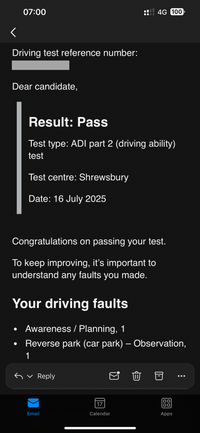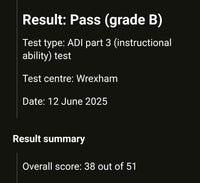The ADI Part 1 theory test is a foundational step for individuals aiming to become Approved Driving Instructors (ADIs) in the UK. This test measures knowledge on topics critical for safe driving and effective teaching and ensures that aspiring instructors have a strong theoretical foundation before moving on to practical training. It includes two parts: multiple-choice questions and the hazard perception test. Here’s a detailed look at each section
1. Multiple-Choice Questions (MCQs)
The multiple-choice section includes 100 questions covering key areas related to both driving and teaching. These questions are categorized into four main sections, each designed to test a different aspect of an instructor's knowledge:
-
Road Procedure:
- This section assesses a candidate's understanding of road laws, driving protocols, road markings, and how to handle various driving conditions safely. It includes rules for driving in different weather conditions, managing various road layouts, and understanding the behavior expected of safe drivers.
- Candidates need to understand situations involving roundabouts, crossings, pedestrian areas, and the intricacies of road sharing with other vehicles and pedestrians.
-
Traffic Signs and Signals:
- This section tests candidates on the identification and interpretation of a wide range of road signs, signals, and markings, which is essential for any driving instructor. It ensures that an instructor can not only recognize these signs but also convey their meaning effectively to learner drivers.
- Signs can range from warning and information signs to regulatory and direction signs, each requiring detailed knowledge.
-
Driving Theory and Hazard Awareness:
- This portion of the test assesses understanding of driving techniques, hazard perception, and the ability to anticipate risks. It covers defensive driving, proper use of mirrors, blind spots, and safe following distances.
- Candidates need to demonstrate an awareness of potential hazards such as cyclists, pedestrians, and sudden obstacles, with a focus on proactive and defensive driving strategies.
-
-
Instructional Techniques:
- This is a key area where candidates are tested on their ability to communicate effectively, provide constructive feedback, and use client-centered learning techniques. It emphasizes the teaching aspect of the role, covering principles of effective instruction and how to adapt to different learner needs.
- Topics include motivational techniques, adapting communication style to various learners, and managing lesson plans for progressive learning.
Each of the four sections contains 25 questions, totaling 100. To pass, candidates must achieve at least 85 correct answers overall, with a minimum of 20 correct answers in each category. This ensures a well-rounded understanding of all areas.
-
Preparation Tips:
-
Study Resources: The DVSA’s "Highway Code," "Driving – the essential skills," and "Know Your Traffic Signs" are crucial for this part of the exam. Additionally, the ADI manual provided by the DVSA includes instructional theory relevant to teaching driving.
-
Mock Tests: Taking mock tests can be helpful in identifying weak areas and familiarizing oneself with the test format. Many online resources and apps provide access to these types of questions and simulated test environments.
2. Hazard Perception Test (HPT)
The hazard perception test is the second part of the ADI Part 1, focusing on a candidate’s ability to detect and respond to developing hazards. This section evaluates how well candidates can recognize potential risks on the road—an essential skill for any driving instructor.
-
Test Format:
- Candidates watch 14 video clips that simulate real-world driving situations. Each clip is designed to include at least one developing hazard, while some may have two, representing risks like pedestrians crossing, sudden braking, or cyclists entering the road.
- As candidates view each clip, they are required to click as soon as they identify a developing hazard. This tests not only recognition but also response speed.
-
Scoring Criteria:
- The hazard perception test is scored out of 75 points, with a pass mark of 57. Candidates are scored based on how quickly they respond to each developing hazard; the sooner they click in response, the higher the score.
- Timing is key, as the clips are calibrated with a “scoring window” that allows a range of points based on the moment the hazard is detected.
-
Preparation Tips:
-
Practice Software: The DVSA offers official software and apps that simulate the hazard perception test experience. Practicing with these tools can help candidates become more familiar with the types of hazards they’ll encounter and improve reaction times.
-
Develop Hazard Perception: Observing traffic and practicing identifying potential hazards while driving can enhance perception skills. Candidates should focus on anticipating potential risks, such as pedestrians near crossings, vehicles stopping abruptly, or cyclists changing lanes unexpectedly.
Passing Criteria and Retake Options
Both sections—the multiple-choice questions and the hazard perception test—must be passed with their respective minimum scores for the candidate to proceed to the next stage, ADI Part 2, which focuses on practical driving skills.
If a candidate fails either section, they have the opportunity to retake the test. Retaking Part 1 can be beneficial, especially if they review their incorrect answers and strengthen areas of weakness. The multiple-choice section, in particular, requires comprehensive knowledge, so dedicating extra time to study and mock tests is often recommended.
Next Steps After Passing ADI Part 1
Once Part 1 is passed, candidates can move on to ADI Part 2, which is a practical driving ability test. This next stage involves an in-depth assessment of driving skills, ensuring the candidate not only understands driving theory but can also apply it in real-world scenarios with a high degree of competence.
Becoming an ADI is a structured and rigorous process designed to ensure that driving instructors are well-equipped to teach safe, effective driving techniques to learners, ultimately contributing to road safety. The Part 1 theory test is a critical step in building that foundation, focusing on both the technical and instructional knowledge necessary for the role.










